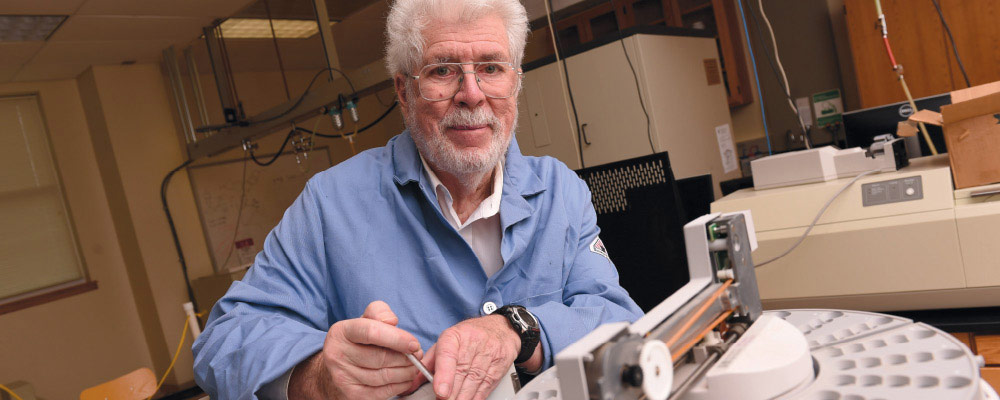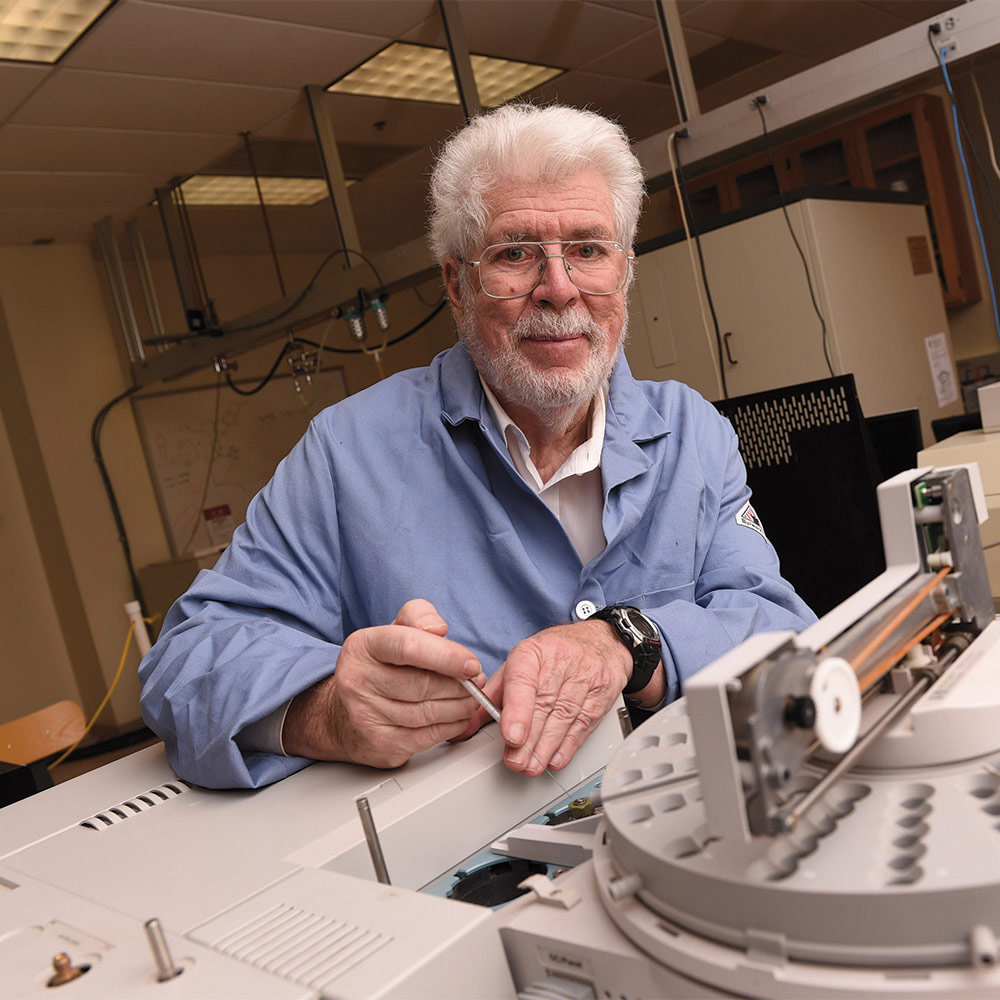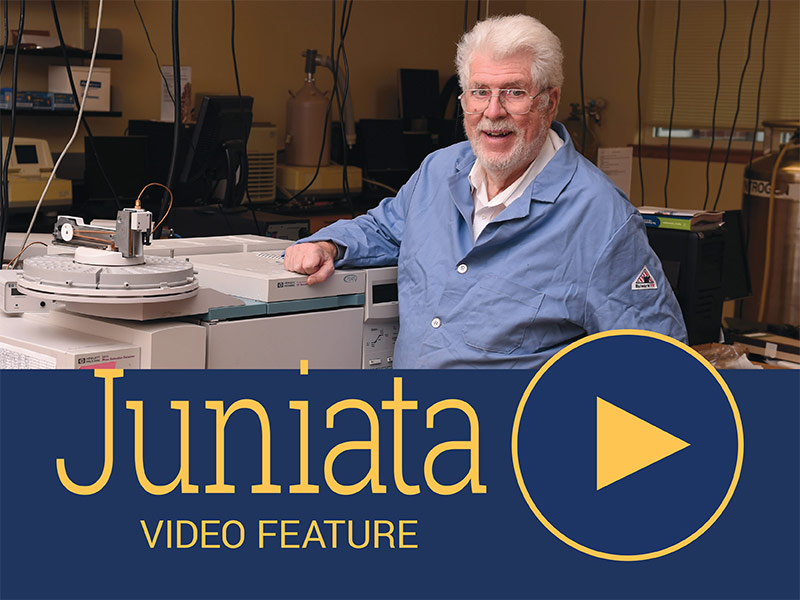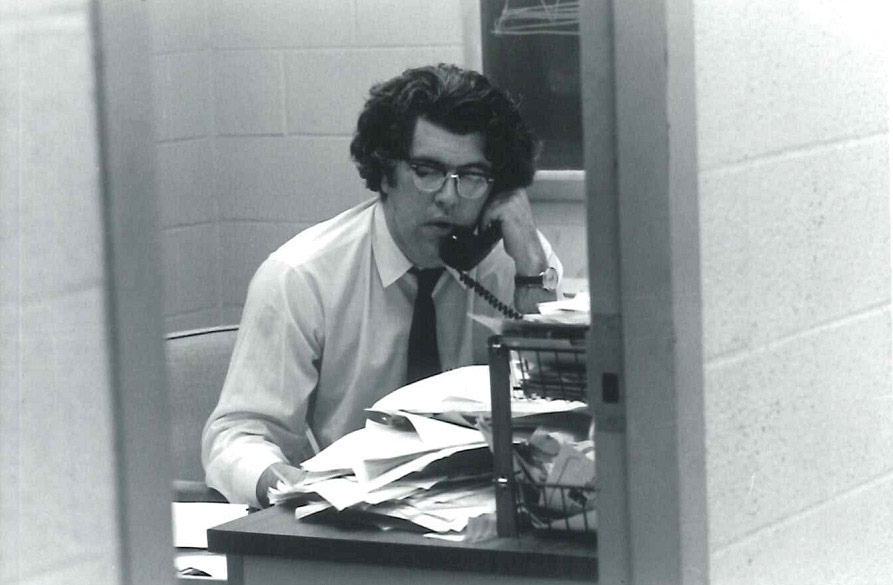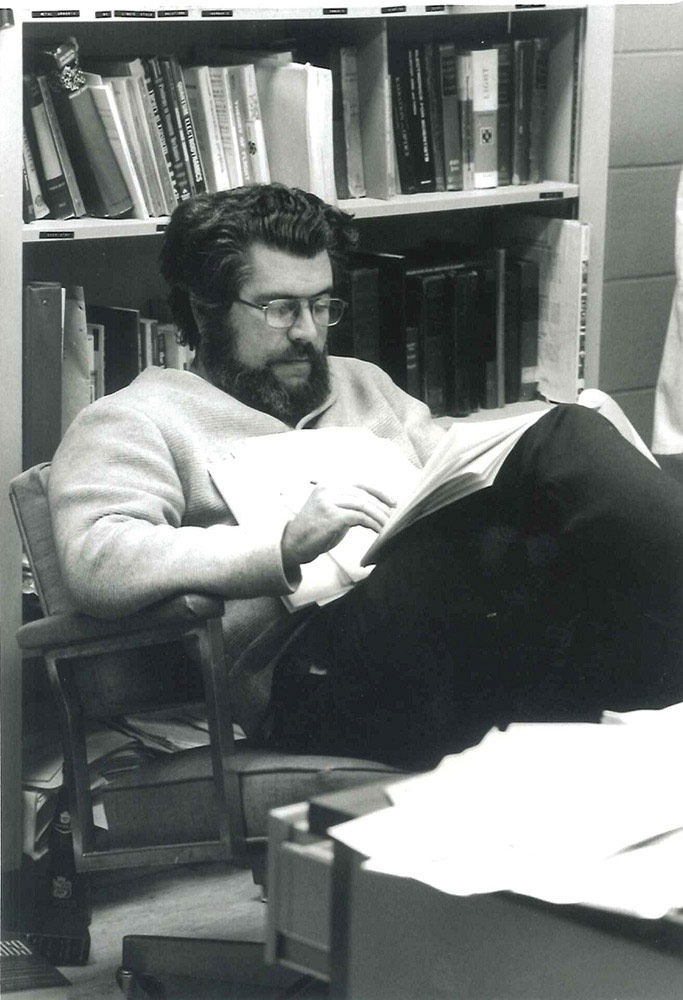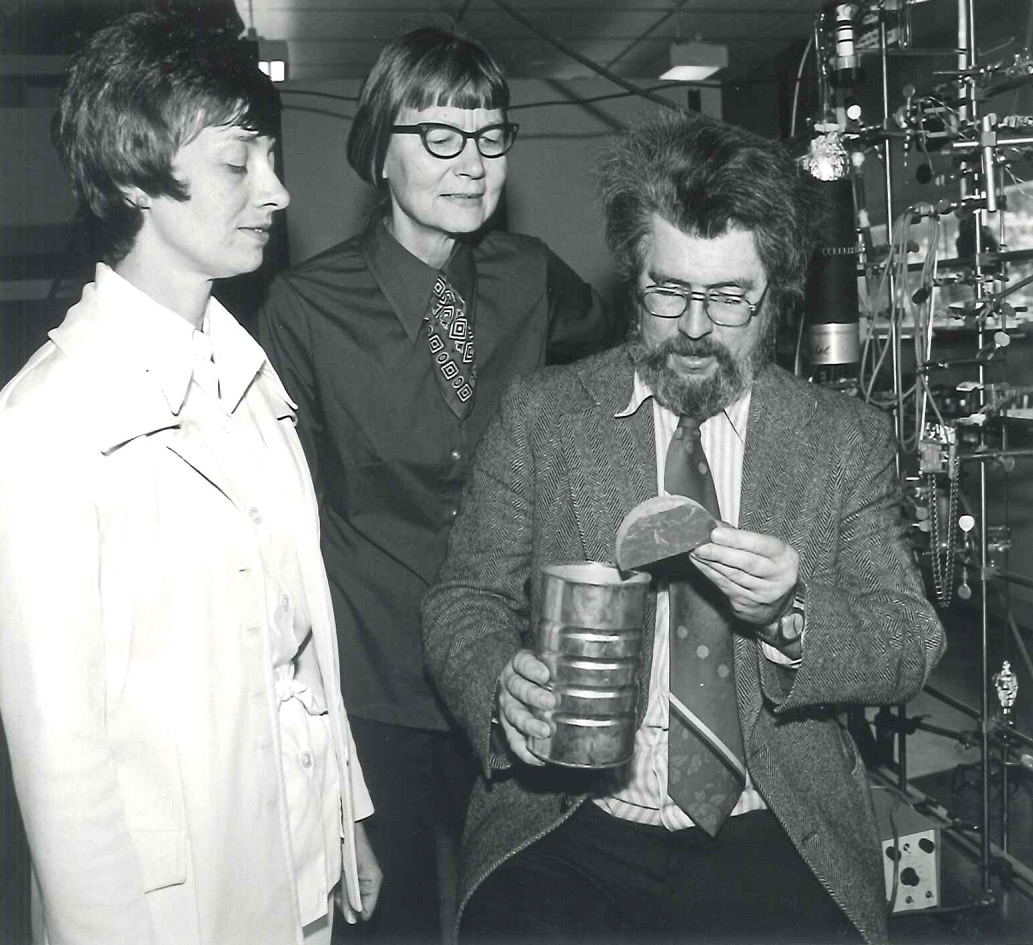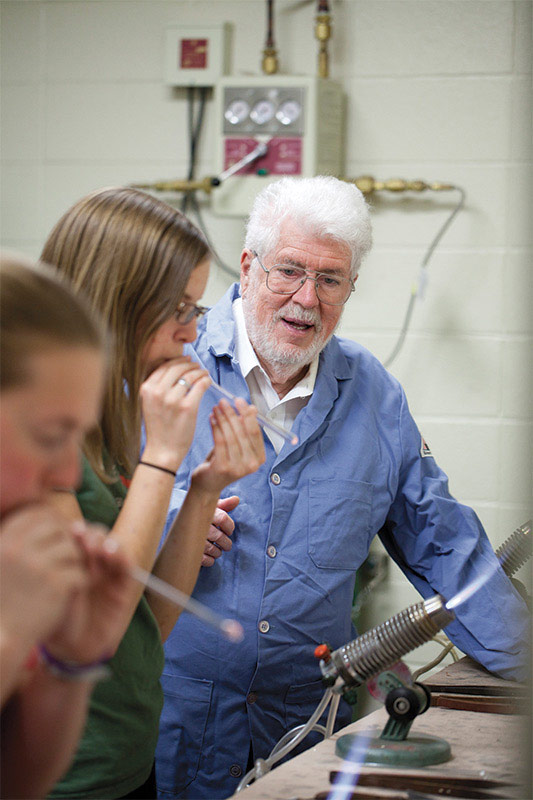When Paul Schettler was about 6 years old in his home town of Salt Lake City, Utah, he started walking home from kindergarten to eat lunch, a distance of about two miles. When he got home, he would take the dog for a walk, usually another multi-mile trek. Soon, his mother, Aurelia, realizing that her young son liked to push beyond familiar environs, had to lay down rules about how far Paul could explore.
His mother, who was a homemaker, had a master’s degree in biology, and Paul Sr., was a Rhodes Scholar at Oxford in philosophy before returning to Utah to take a job as a trust officer at a local bank. So, when talk at the dinner table turned serious, we’re talking deep, deep topics.
“My dad was a philosophy major, so I remember reading The Death of Socrates and reading Immanuel Kant at a very young age,” he recalls.
“He is a deep thinker, and he is interested in complicated subjects,” says William Russey, professor emeritus of chemistry, who with fellow chemist Dale Wampler, hired the man most people call “Schetts.” “But it’s enjoyment and a sense of mission that drives both his teaching and research.”
"I always had questions about the nature of things from an early age."Paul Schettler, Charles A. Dana Professor of Chemistry
That sense of curiosity and deep thought blossomed early—in the 4th grade, when he read his dad’s high school texts on physics and chemistry. He picked up chemical concepts right away, but the math associated with physics stumped him. He begged his mother to let him quit piano lessons so he could hire a math tutor. Eventually, though, math struck the right key for him and he left home in 1958 to study chemistry at the University of Utah.
At the time, Schettler wasn’t ready to push beyond the Utah state line in pursuing his education but he was making up for that in his spare time. As might be guessed from his childhood penchant for walking, Schettler turned his love of exploration into a hobby. He did a lot of mountain hikes in Utah and other states. As an undergraduate in 1956 he joined an expedition to explore Neff Canyon Cave, one of the deepest caves in the U.S., to find the bottom of the historic site.
The love of outdoors extended to his romantic life, as Schettler met his wife, Karen, at a meeting of the Wasatch Mountain Hiking club. At Utah, he had been a student who learned by asking questions of all his professors. “It helped me learn the logic of things and gain a metaphysical vision of the universe,” Schettler says. “I wanted everything to be tied together.”
The young student found his Utah professors open to such exchanges of information and Schettler was energized in challenging his teachers. He saw it as very much a precursor to the idea of interdisciplinary education.
His idealistic love of Socratic interchange with his professors was shattered when Schettler left the west to study chemistry in the Yale University doctoral program. “I chose it because it appeared to have the most opportunities for connection to the worlds beyond science,” Schettler explains. “It turned out that the chemistry department was very isolated. There wasn’t much communication with other departments and very little within the department. They all stayed in their own discipline.”
At Yale, Schettler began working on research on solvated electrons, which are free electrons in a solution that are useful in forming chemical compounds, particularly in radiation chemistry. Although the Yale chemistry department was less than thrilled with Schettler’s Socratic method of learning, he thrived in his research, enough to secure a postdoctoral position at Yale in 1963. Then, in 1964, he spent three years back home at the University of Utah training with Calvin Giddings (“One of the geniuses in the field,” according to Schetts) on gas chromatography.
As the Utah work drew to a close, Schettler knew he did not want to enter industry. His need to know how the universe worked and how the universe related to what he was particularly interested in meant he needed to interact as a planet in a universe of experts willing to talk to him. In other words, a college campus.
The thing was, as his postdoctoral stint drew to an end, teaching positions were as rare as an oscillating reaction. “When a college had an opening, it was normal to receive at least 1,000 applications,” Schettler recalls. He also realized he had better get some teaching experience.
Which brought the young chemist to the campus of Antioch College, perhaps one of the most progressive, liberal, inclusive, —pick your adjective—campuses in the United States, to do a “teaching postdoc,” sponsored by the Kettering Institute. “It was amazing, everyone was talking to everybody and I loved every minute there.”
The Antiochian year gave Schettler insight into how he wanted to teach. He wanted to gather people together and exchange ideas. “I owe that to my father, I was looking for philosophical dialogues,” he recalls. Near the end of his fellowship, he saw an ad for a position in chemistry at Juniata. Ever willing to walk beyond his previous experience, Schettler applied and corralled an interview. He talked to many science faculty during the interviews, but the faculty member with whom he had intellectual chemistry? The late Esther Doyle, professor emeritus of English. “We had a great conversation and I thought Juniata would be a great place.”
He jumped into teaching. A full load of chemistry, but he also taught “Modes of Thought.” “I remember reading a poem about a hawk and thinking, ‘How do I do this?’ They didn’t do this at Yale!” Over time, though, Schetts settled in and found that students responded to his “interchange of ideas” style.
“I always have thought of Paul as one of those Cambridge dons who live in the same house as their students,” says Don Mitchell, professor emeritus of chemistry and who joined the faculty a year after Schettler. “He spent at least as much time with students in voluntary homework sessions as he did in the classroom.”
“Teaching consists of leading students along until they get their own ideas, and then can work to solve problems that are self-generated,” Schettler says.
Teaching and research occupied his time at work, but Schettler realized it was important to keep exploring at home too. It was not unheard of for him to take deep walks into the forests near his home. Then as his family grew, with the arrival of son George, and daughter Becky, he brought his children into his world of exploration. A list of their family trips reads like Call of the Wild. The Schettlers have trekked to Alaska, Ellesmere Island, Baffin Island, Banff, and even Nepal in the shadow of Mount Everest.
During his extensive research career, Schettler also set off on uncharted trails. He started his research at Juniata as a continuation of his work with solvated electrons. Then, in the 1970s, he discovered a new challenge in the world of, —to paraphrase Mick Jagger—, gas, gas, gas.
"He spent at least as much time with students in voluntary homework sessions as he did in the classroom."Don Mitchell, professor emeritus of chemistry
Ironically, Schettler’s gas adventures do not begin with a Socratic dialogue. It was more like a request from then-Juniata President John Stauffer. Stauffer, a member of the board of Ohio’s Columbia Gas Corp., asked the chemist to see if he could solve a problem—why some shale wells produce gas, but most don’t.
He began by trying to measure the permeability and started down a research path that would garner more than $1.3 million in research grants from the U.S. Department of Energy, the Gas Research Institute, TerraTek Corp and Columbia Gas.
Schettler’s experimental method for permeability put shale samples under pressure using methane gas. He pressurized the sample, then released the pressure while sealing the apparatus. If pressure rose in the sealed area, that meant the shale was permeable and natural gas could flow through it.
By the late 1970s, Schettler was taking teams of students on drill sites and employed lab managers measuring shale samples. By the 1980s, Schettler was working on how to tell how much gas flowed through the rock. In 1981 he went on sabbatical and, with Todd Gustafson, professor emeritus of biology, designed a flow meter and an instrument that could estimate gas concentration.
The invention of those two instruments eventually spelled the death of Schettler’s gas research. Flow meters turned research into business. The gas company wanted him to go measure wells throughout Appalachia, while Schettler was happiest solving problems by discussing ideas with his students and colleagues. His student researchers needed lab experience that would directly help them after leaving Juniata. Eventually, Juniata and the gas companies parted ways and Schettler sought out a new research idea. He spent 17 years working to design new analytical columns for gas chromatographs and has spent the last six years doing computational chemistry using a Terrachem computer, a calculating wizard that uses 800 processors.
“Thirty years after graduation, I still lecture and use material I learned from Paul,” says Frank Dorman ’87, associate professor of chemistry and molecular biology at Penn State University. “I have traveled extensively in a technical capacity, and work at a research university. I have met many competent scientists. Paul is still my ‘go-to’ collaborator for thermodynamics and molecular modeling. He was in 1987, and he still is today.”
"Thirty years after graduation, I still lecture and use material I learned from Paul."Frank Dorman ’87, associate professor of chemistry and molecular biology, Penn State University
Never willing to slow down or take it easy, Schettler has maintained the same schedule of classroom work and tutoring sessions. The payoff is that he continues to mentor students who leave Juniata to do great things. Zhongwei Hu ’12 just finished his doctoral studies at Penn State. Leslie Vogt ’05, has pursued her research career from Harvard to Yale to NYU, where she is an assistant research scientist in chemist Mark Tuckerman’s lab.
“Through his innovative approach to grading exams on a personalized curve and providing individualized class projects, Schetts was one of the professors at Juniata who truly taught me how to learn,” says Vogt. “It is rare for a professor to spend so many hours helping students find their way through problem sets outside of class, which was especially needed for one of the most difficult courses in the chemistry major. We were always in awe that he could amble into the classroom with no notes and proceed to fill the boards with an hour’s worth of derivations.”
All of Schettler’s explorations started with a simple question and as he nears the end of his path he is asking a few questions about leaving a legacy.
“Paul would not be able to exist without teaching,” says Peter Baran, associate professor of chemistry and a longtime colleague. “I am sure that even after this formal retirement he will seek ways to be involved in the departmental teaching activities and he deserves our appreciation for that. I am sure that he was speaking about fear of life without teaching when he created his famous line: ‘I will never retire. I will be carried out of my office.’ His teaching method employed whatever study methods brought results. The only thing he has always cared about is that students learn about physical chemistry.”
Starting in the 1990s, Schettler began using his personal funds to underwrite summer research in the chemistry department. In 2012, he shifted the process of choosing grantees to the provost’s office. In 2014, he decided to use $20,000 per year for what he dubbed Innovation Educational Improvement grants. Faculty can apply for them to fund “the most imaginative and innovative examination of what is being taught (in the classroom).” The faculty awarded the grants receive up to $10,000 that can be applied to a research program or a classroom innovation. Recent faculty recipients include chemist Sharon Simpson Yohn ’99, biologists Jason Chan and Chris Grant, historian Peter Rothstein, language professors Jim Roney and Henry Thurston-Griswold, and Amanda Siglin, director of the health professions program.
Looking ahead, Schettler will continue his legacy of learning by making provision in his will to establish an endowment of $400,000 to continue these grants after his passing.
“The one thing I was impressed with at Juniata was how the faculty reached out to each other through coffees, meetings, dinners, and activities,” he says. “There was a refusal to let people become isolated and everyone wanted you to feel a part of the community. That’s what I’ve tried to do here through my classes and in these donations for research and teaching. I hope it has had an impact.”
"We were always in awe that he could amble into the classroom with no notes and proceed to fill the boards with an hour’s worth of derivations."Leslie Vogt ’05, assistant research scientist, New york university
